Sometimes it is not the age of a painting which leads to deterioration, nor is it the environment or accidental damage. Paintings can be innately flawed by their production process, in which the artist may not have properly prepared the base or the materials, such as the canvas. The same can be said for all manner of antique items and artworks, as well as modern and contemporary pieces. The longevity of an artwork is often intertwined with the skill that went into its creation.
The reason why so many historic artworks exist today is because of their expert preparation. An artist’s studio would have a team of craftsmen working on the process which preceded the composition of the painting. Specialist pigment merchants and canvas suppliers, known as colourmen, had locations across cities and are the unsung figures behind great works of art.
However, some artists who might not have had enough experience, connections, or finances may have attempted to create a painting with their own means and with no training, especially from the 19th century onwards when painting may have been taken on by hobbyists. As the 20th century progressed a pursuit of art became evermore accessible, and by the 1960s the ability to experiment with various materials and new techniques became commonplace. However, these modern and contemporary artists, many of which were not traditionally trained, may have used deteriorating materials or failed to prepare their canvas entirely.
This leaves conservators with an interesting conundrum, as many paintings may come to them with a failure of the original preparation which needs to be implemented at a later date by themselves. Luckily, precise techniques can be used to readhere flaking paint and to stabilise a precarious artwork. In this article we will cover some of the treatments which may be used to save a failing painting, as well as how paintings should be prepared and common defects you may encounter in antique and contemporary artworks.
How are paintings prepared?
The most important step to oil painting preparation is in creating a suitable surface, whether this is on canvas or wooden panel. Traditional oil paintings are created in layers, which can be examined through cross section analysis by conservators.
 Above: a detail from Self-Portrait with Two Pupils by Adélaïde Labille-Guiard, 1785
Above: a detail from Self-Portrait with Two Pupils by Adélaïde Labille-Guiard, 1785
A canvas is usually made from linen on stretcher bars which tension the fabric. A properly tensioned canvas is key in ensuring that the paint layer does not move or press against the wooden bars. The canvas is then prepped with a ‘size’ or ‘ground’ layer such as a primer to protect the linen from any acidity and to reduce the absorbency of the paint. Traditionally this was an animal glue with white paint and chalk or white lead. The correct consistency, as well as leaving this layer to dry fully, is important in avoiding flaking and unstable paint.
 Above: a contemporary artist applying paint to a canvas
Above: a contemporary artist applying paint to a canvas
The construction of a wooden panel was traditionally a time-consuming task. Firstly, a carpenter would cut a piece from often a willow, poplar, or linden tree, using a technique known as a radial cut (going against the grain of the timber). Although some pieces use just one piece of wood, others may have several different parts joined together to create the appropriate size. This was then levelled and sanded down for a smooth base, before being covered with resin and linen either by a specialist merchant or within the artist’s studio. A final step would apply layer upon layer of a chalky mixture known as gesso. Each layer is applied and then sanded down when dry. This is completed over a few days or weeks, with the base building up to a texture, not unlike ivory. Some artworks have as many as 15 layers of gesso beneath their surface. With so many steps involved, you may see why some artists may have skipped traditional preparation techniques.
 Above: a portrait of the artist James-Jacques-Joseph Tissot by Edgar Degas in a studio, to the right you can see several canvas paintings
Above: a portrait of the artist James-Jacques-Joseph Tissot by Edgar Degas in a studio, to the right you can see several canvas paintings
You may find oil or acrylic paintings on surfaces such as paper, slate, linoleum, pressed wood and cardboard. These all face their own challenges, as their preparation has no tried and tested approach as you may find with traditional mediums, making their stability sometimes difficult to predict by the artist or the owner.
The colours of an oil painting are created with dry pigments mixed with a binder, in most cases this is refined linseed oil. The mixture must form a stiff but smooth consistency, avoiding any sticky or stringy paste. Some artists produce a very thin paint layer, which is later vulnerable to flaking because it lacks rigidity and strength. Whilst others prefer an impasto approach – where thick paint (often acrylic) is applied with a palette knife to produce a three-dimensional effect. Paintings with thick and heavy layers such as impasto may require extra preparation to ensure the canvas can hold the weight to the surface.
 Above: a painting featuring the London studio of Benjamin West and other American artists in England, 1765
Above: a painting featuring the London studio of Benjamin West and other American artists in England, 1765
Finally, a painting is usually varnished to protect it from the atmosphere and to give the colours further saturation. Some historic varnishes remain sticky due to their consistency, making them easily attract dust and debris. Others may have trapped dirt and contaminants under the surface in the artist’s studio, or been applied unevenly with some areas failing to set correctly – leaving some parts of the painting at higher risk of damage. Other paintings may not have been varnished at all, this leaves them with a vulnerability to airborne contamination such as smoke and nicotine landing directly upon the paint layer and lessened UV protection.
 Above: an example of cross section analysis which is used to analyse each layer of a painting under a microscope
Above: an example of cross section analysis which is used to analyse each layer of a painting under a microscope
Is my painting failing?
The most obvious sign of a failing painting is the falling away of the paint layer from the canvas, this is especially the case with heavy impasto paintings whose canvas preparation was not strong enough to adhere this to the surface. The paint layer may begin to present widespread cracking, before flaking in small and large pieces.
 Above: a painting with large areas of flaking paint (left) which was restored by our conservators (right)
Above: a painting with large areas of flaking paint (left) which was restored by our conservators (right)
A large and visually disturbing cracking pattern may also emerge over time, due to loose tensioning of the canvas or the lack of preparation beneath the paint layer. Whilst all paintings have a thin layer of cracking, known as craquelure, deep and wide cracking can be problematic and extremely damaging to the stability and appeal of a painting. This can be caused by accidental damage, old age, or bad preparation.
 Above: the oils from the paint sinking into the canvas causing further instability due to the lack of canvas preparation and ground layer
Above: the oils from the paint sinking into the canvas causing further instability due to the lack of canvas preparation and ground layer
Sometimes a paint and varnish layer may also begin to sag, leaving a wrinkle or warping to the paint layer. This is a serious type of damage, along with blistering, that requires a fast response from conservators to stabilise.
An ill-prepared canvas will lead to absorption of the oils from the paint, making some areas greasy and discoloured. The canvas may require re-lining to strengthen against this deterioration of the fabric as it comes under stress from the oils or chemicals in the paint.
 Above: a painting with heavy impasto that was falling away from the canvas, restored in our studio by our conservation team
Above: a painting with heavy impasto that was falling away from the canvas, restored in our studio by our conservation team
A canvas can become loose over time and require re-tensioning, but it may also have been badly constructed. You may be able to see the lines from the stretcher bars through the paint layer, as well as the canvas having an obvious bend or movement, risking the stability of the piece.
Restoring a failing painting
We have had numerous examples of bad painting preparation in our studio, however three pieces stand out to us, as they were all by the same artist – concluding that it was certainly a case of a weak preparation process.
 Above: two out of the three of the paintings which have come to our studio by the same artist
Above: two out of the three of the paintings which have come to our studio by the same artist
The only thing we know about these floral impasto paintings is that one of them was purchased in Liberty of London in 1969 and so we can assume that the others were created around the same time. They are signed with ‘Frost’ but we do not know how many of these pieces were created or survive today. Although they seem obscure, three of these bright artworks came to our attention due to an intense cracking and flaking of the paint layer.
 Above: the cracked and flaking impasto paint layer on one of the floral paintings
Above: the cracked and flaking impasto paint layer on one of the floral paintings
Upon inspection, our conservators discovered that these paintings had no ground layer. That is, they had no base or preparation for the canvas. Therefore the paint had simply been applied straight away, leaving the canvas prone to the oils absorbing into the fibres and the paint highly unstable.
 Above: a close-up of the paint lifting away from the canvas on the floral artwork
Above: a close-up of the paint lifting away from the canvas on the floral artwork
Our team fully consolidated the artwork, this including carefully reapplying broken pieces like a jigsaw puzzle. It is important to always keep broken paint, as where possible our team will always prefer to reapply this rather than retouch with new pigments for the integrity of the artwork. Each broken piece was adhered with conservation appropriate adhesive, carefully injected beneath lifting paint to secure it back against the canvas. Following this, any lost areas could be sympathetically retouched.
 Above: the flaking pieces which had been saved, ready for our conservator to gentle re-apply them to the canvas
Above: the flaking pieces which had been saved, ready for our conservator to gentle re-apply them to the canvas
As well as restoring the damage, our team also considers measures for future safekeeping. This includes the installation of a backing board to secure the canvas further and prevent any movement which may trigger cracking to return, as well as appropriate framing.
Above: our conservator carefully consolidating the paint layer and replacing the missing pieces of paint
A deeper frame helps to keep the paint layer away from harm, setting it back so it cannot be easily touched as people pass by or move it in the future. We also recommend glazing as an extra layer of protection, as the painting is not varnished and the impasto is sensitive to a build up of dust and debris.
 Above: one of the floral paintings before and after conservation by our team
Above: one of the floral paintings before and after conservation by our team
This painting is not a surprise from the late 1960s, as many art students and up and coming artists did not have traditional training. In fact, many went to art school and were encouraged to go against the standard practices. Another piece which our team restored was an abstract view of a client’s neighbourhood which he completed as an art student in the 1960s. Many different materials were found in the piece, as well as an uneven surface and a mixture of varnished and unvarnished areas. Our conservators love a challenge and were motivated to protect this unique piece of art from preventable deterioration, they were fascinated by the construction which goes against the practices they usually come across in fine art.
 Above: a detail from a 1960s student artwork which was restored by our conservation team
Above: a detail from a 1960s student artwork which was restored by our conservation team
Restoration is possible whether a painting has already faced damage or may be in danger of falling victim to the lack of preparation in the future. Our team can provide preventative methods to ensure the safety of all artworks, no matter their value, age, or background story.
Get in touch with our team
If you need to know how to save a failing artwork or if you have a painting which is flaking, cracking, or seems unstable in any way, please contact our team for swift and helpful advice.
You can speak to our team by emailing [email protected] or by calling us on 0207 112 7576.

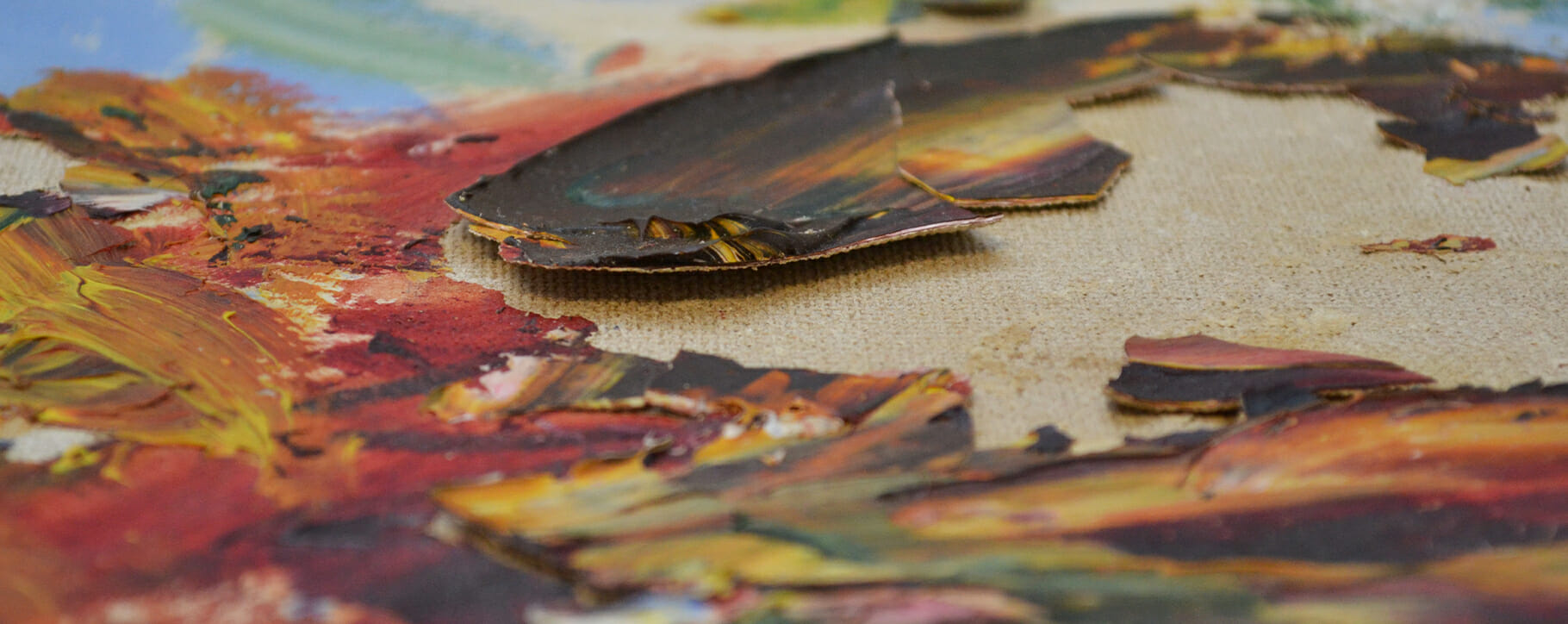

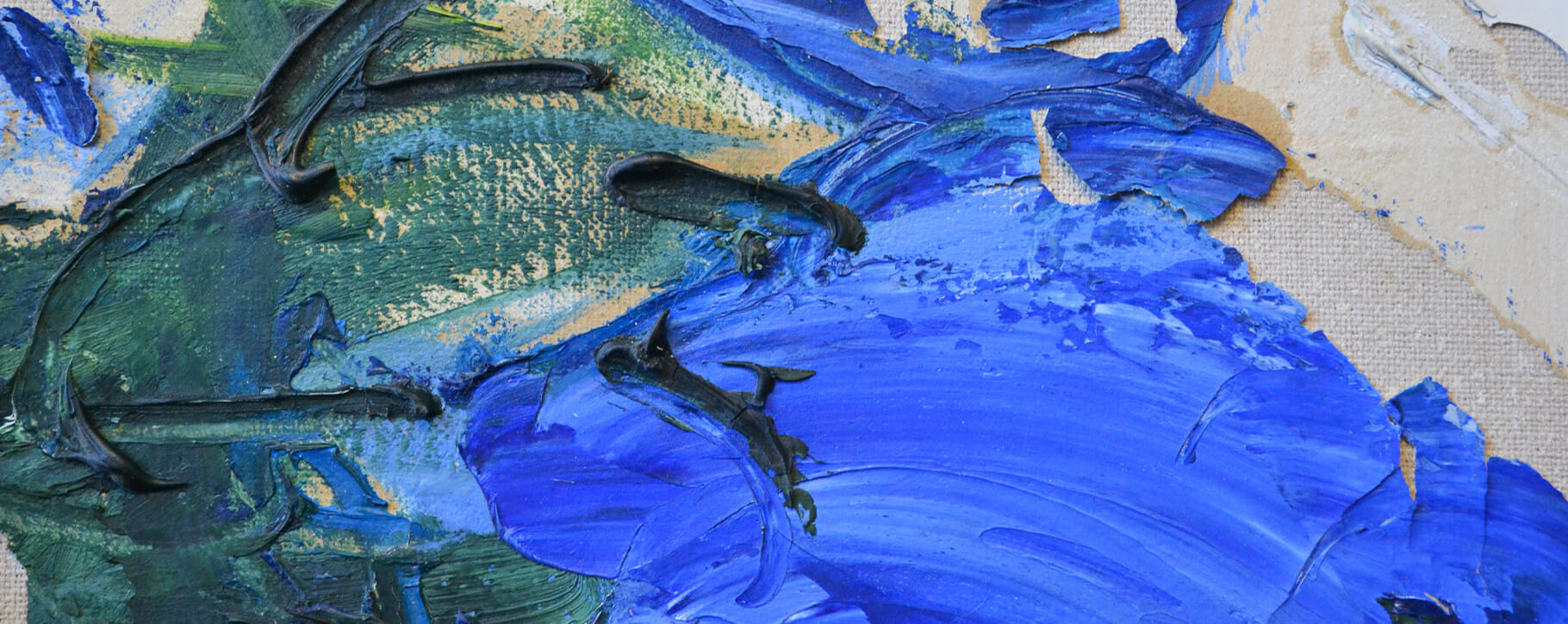
 Above: a detail from Self-Portrait with Two Pupils by Adélaïde Labille-Guiard, 1785
Above: a detail from Self-Portrait with Two Pupils by Adélaïde Labille-Guiard, 1785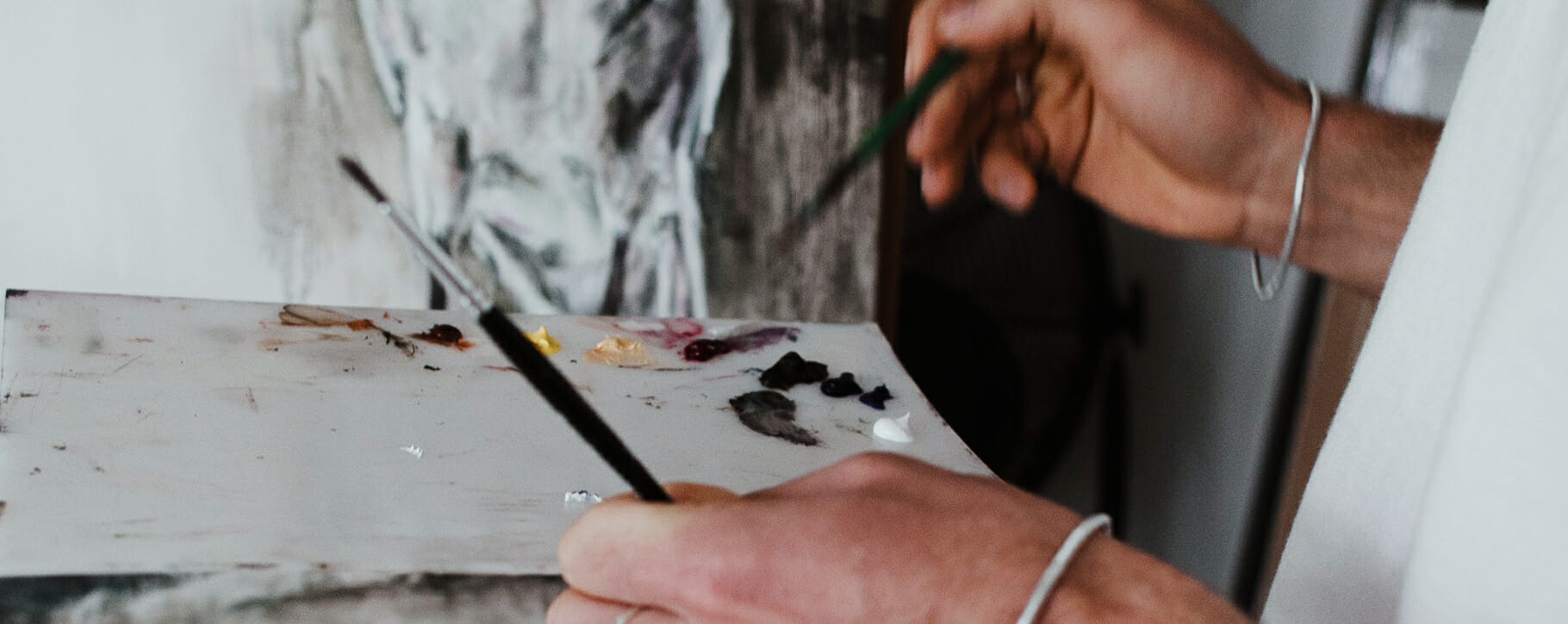 Above: a contemporary artist applying paint to a canvas
Above: a contemporary artist applying paint to a canvas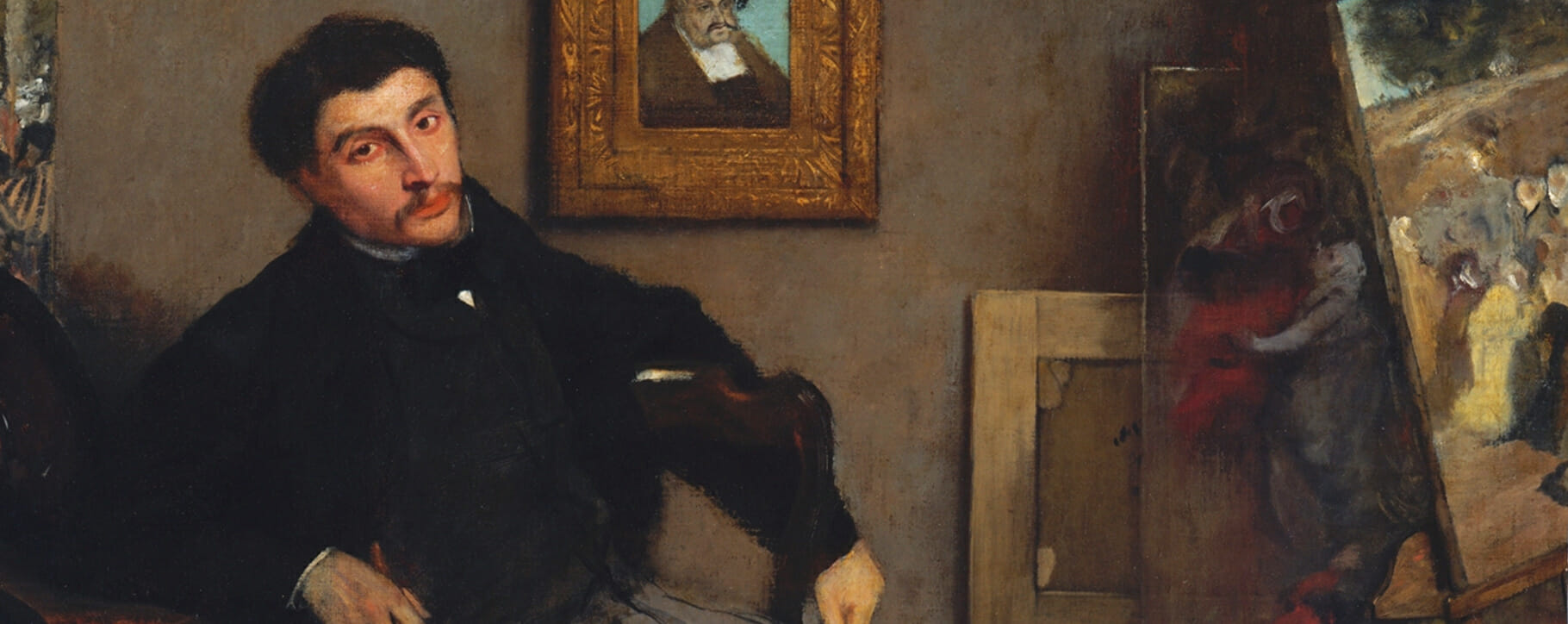 Above: a portrait of the artist James-Jacques-Joseph Tissot by Edgar Degas in a studio, to the right you can see several canvas paintings
Above: a portrait of the artist James-Jacques-Joseph Tissot by Edgar Degas in a studio, to the right you can see several canvas paintings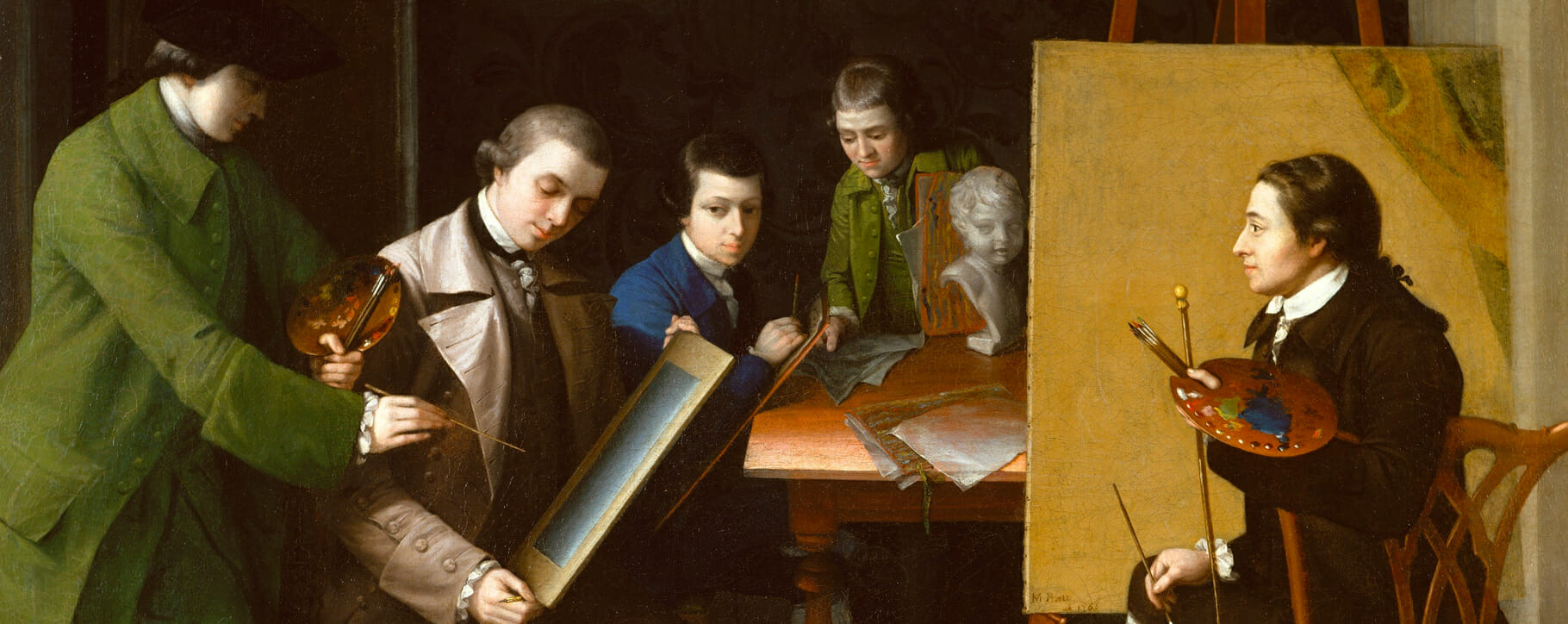 Above: a painting featuring the London studio of Benjamin West and other American artists in England, 1765
Above: a painting featuring the London studio of Benjamin West and other American artists in England, 1765 Above: an example of cross section analysis which is used to analyse each layer of a painting under a microscope
Above: an example of cross section analysis which is used to analyse each layer of a painting under a microscope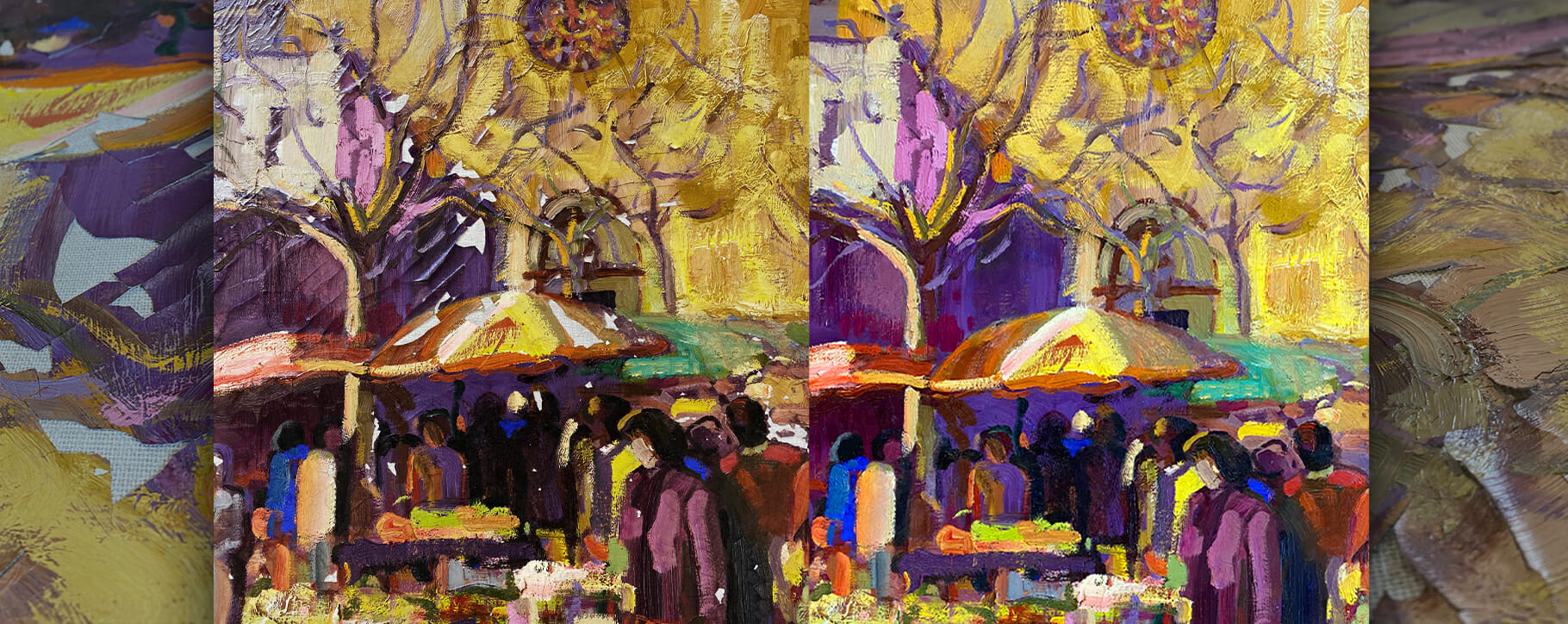 Above: a painting with large areas of flaking paint (left) which was restored by our conservators (right)
Above: a painting with large areas of flaking paint (left) which was restored by our conservators (right)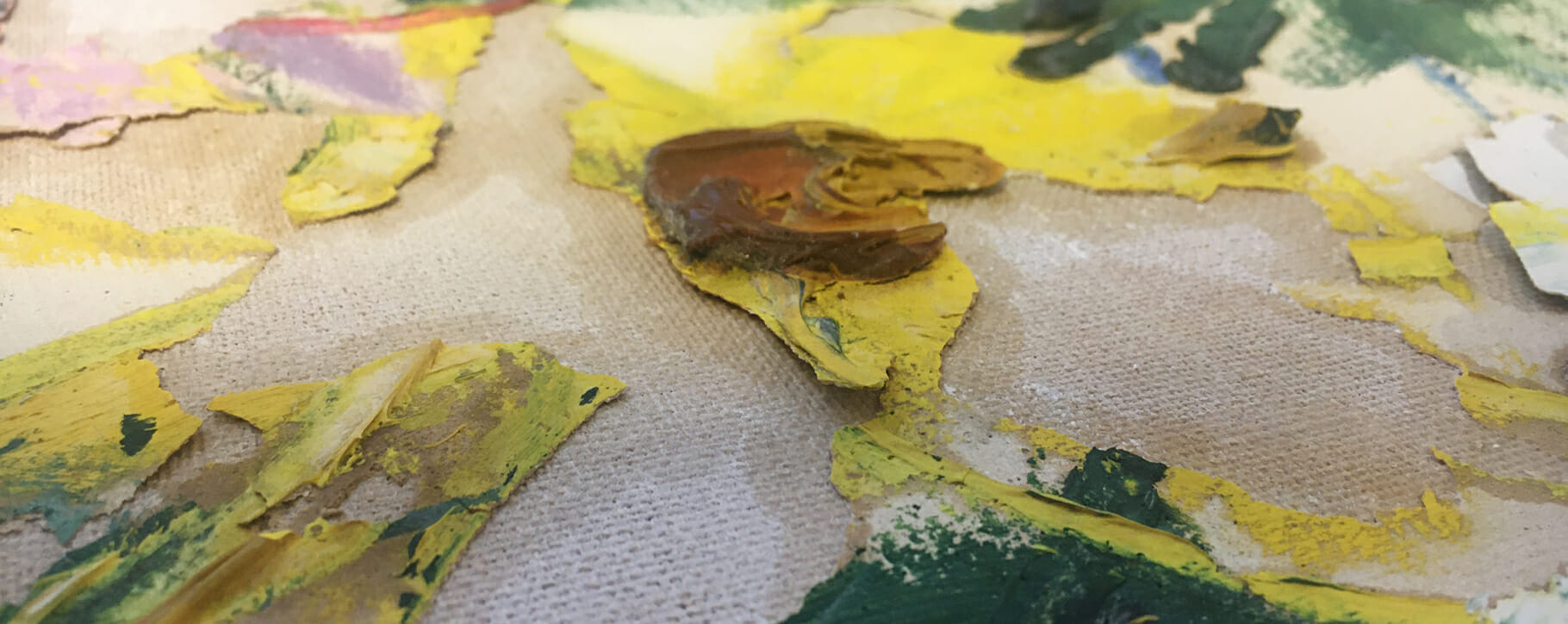 Above: the oils from the paint sinking into the canvas causing further instability due to the lack of canvas preparation and ground layer
Above: the oils from the paint sinking into the canvas causing further instability due to the lack of canvas preparation and ground layer Above: a painting with heavy impasto that was falling away from the canvas, restored in our studio by our conservation team
Above: a painting with heavy impasto that was falling away from the canvas, restored in our studio by our conservation team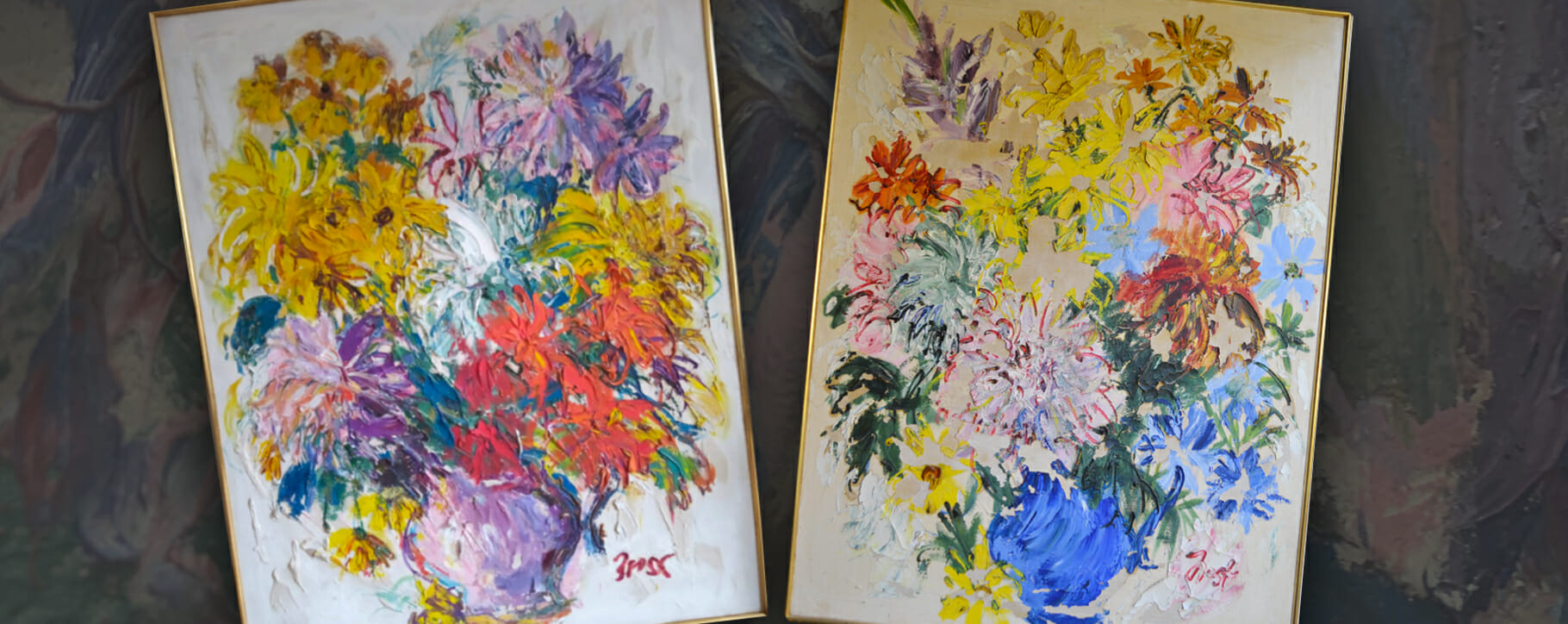 Above: two out of the three of the paintings which have come to our studio by the same artist
Above: two out of the three of the paintings which have come to our studio by the same artist 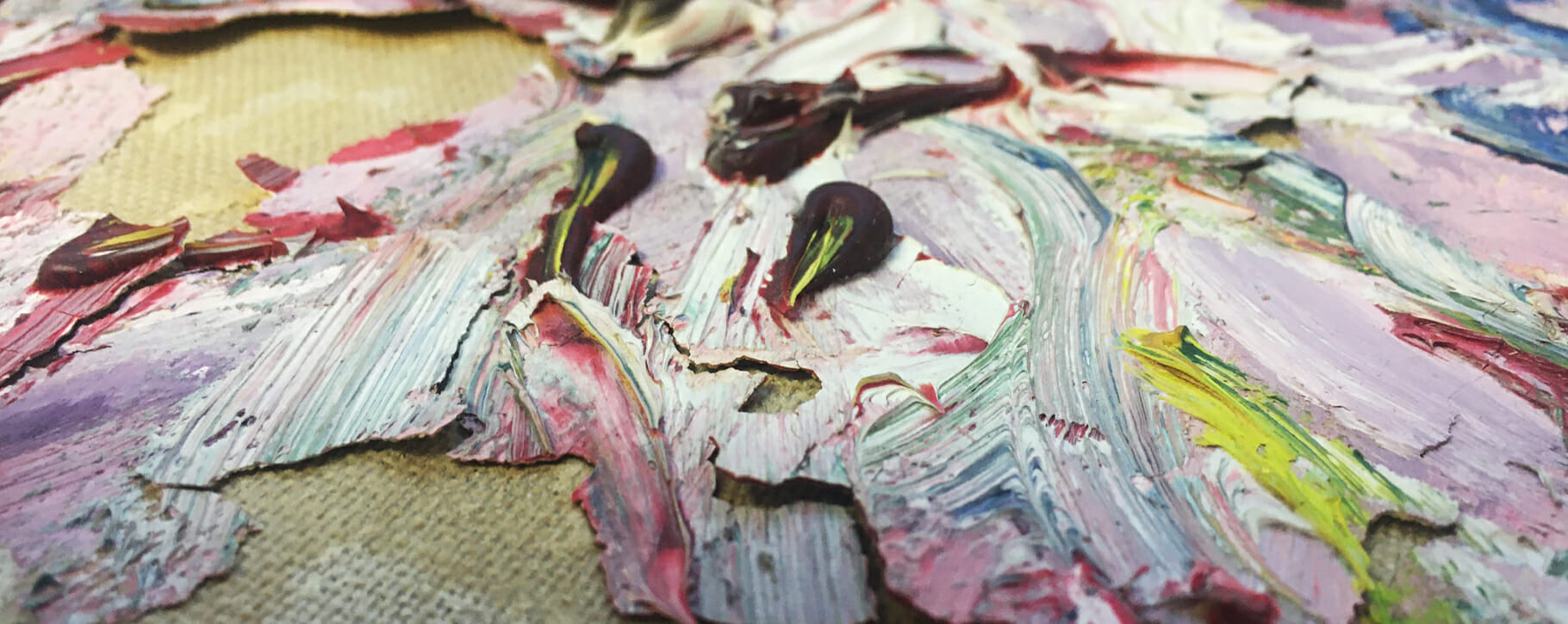 Above: the cracked and flaking impasto paint layer on one of the floral paintings
Above: the cracked and flaking impasto paint layer on one of the floral paintings Above: a close-up of the paint lifting away from the canvas on the floral artwork
Above: a close-up of the paint lifting away from the canvas on the floral artwork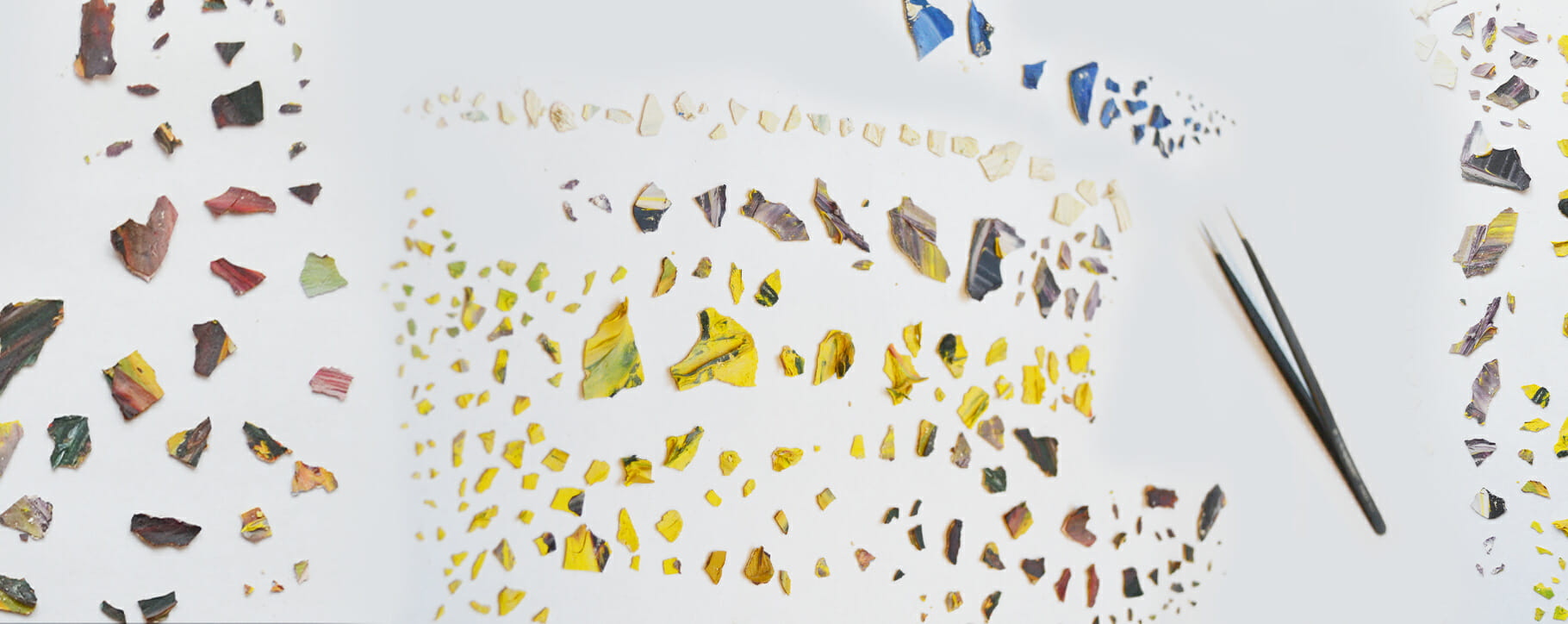 Above: the flaking pieces which had been saved, ready for our conservator to gentle re-apply them to the canvas
Above: the flaking pieces which had been saved, ready for our conservator to gentle re-apply them to the canvas 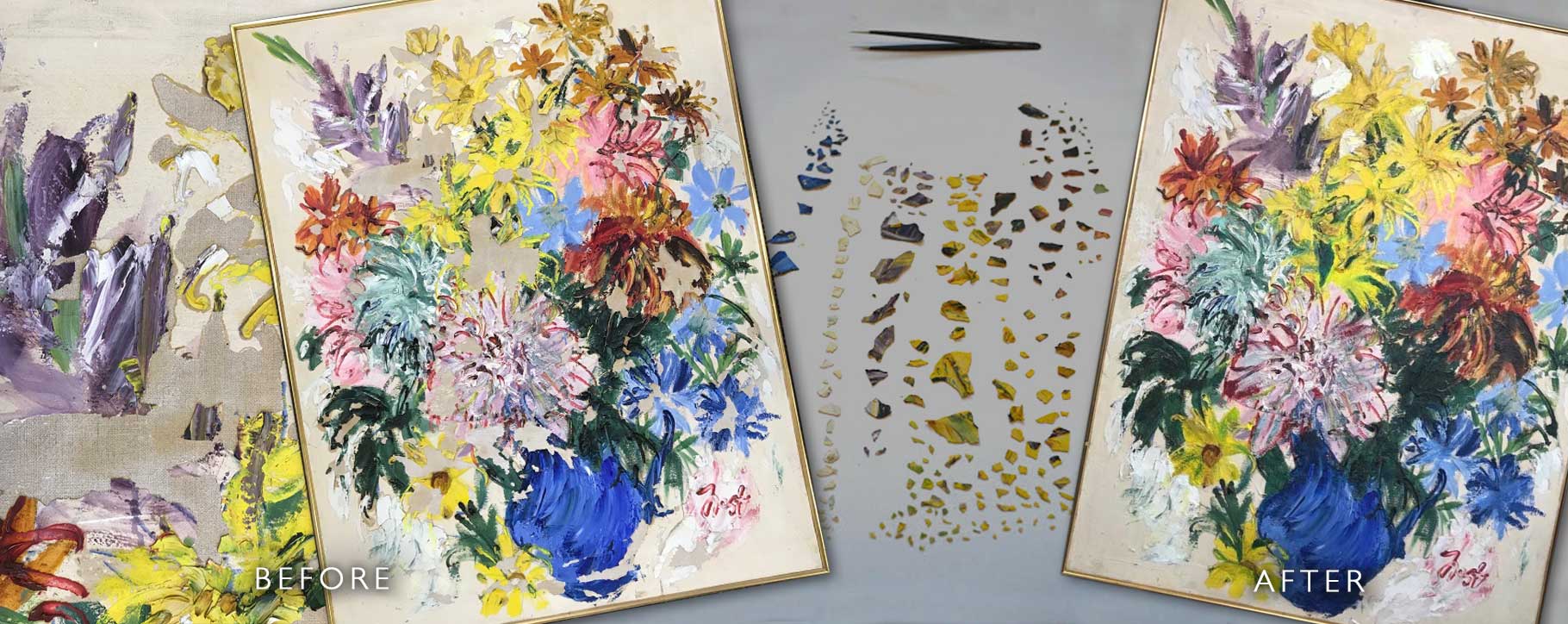 Above: one of the floral paintings before and after conservation by our team
Above: one of the floral paintings before and after conservation by our team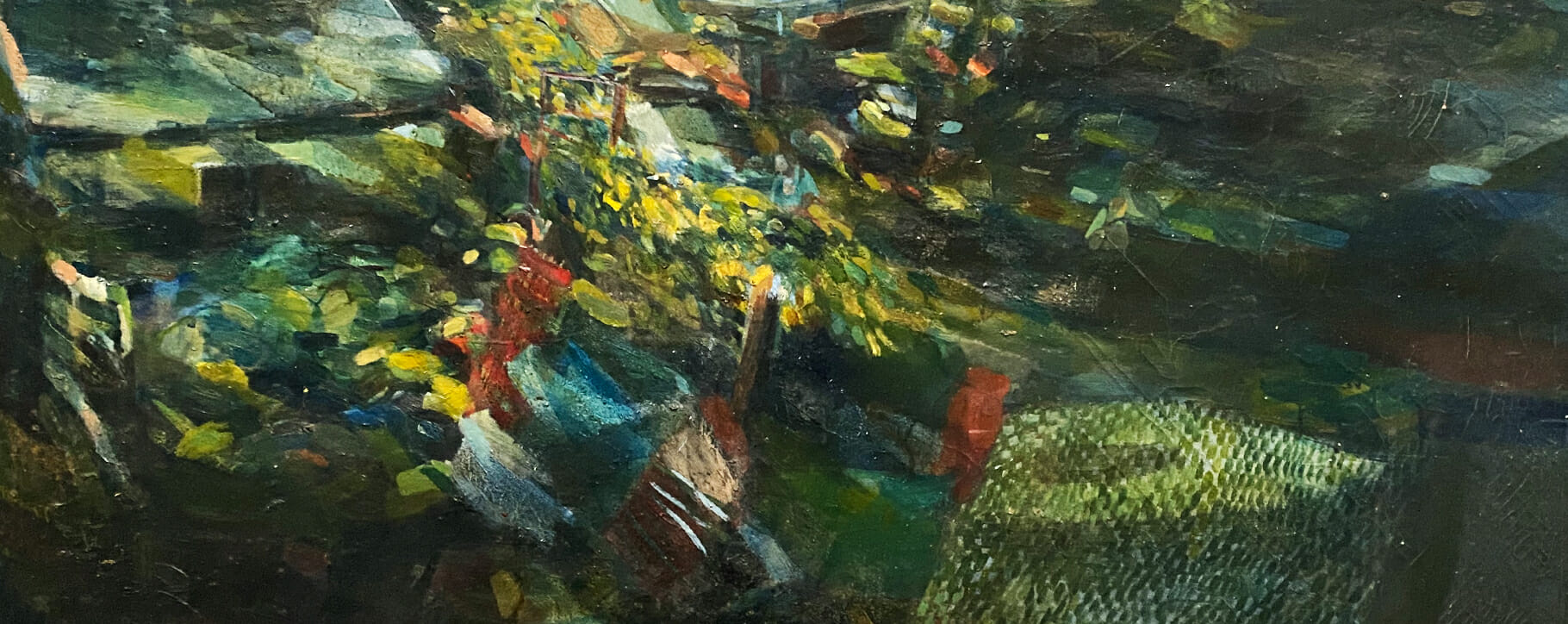 Above: a detail from a 1960s student artwork which was restored by our conservation team
Above: a detail from a 1960s student artwork which was restored by our conservation team




